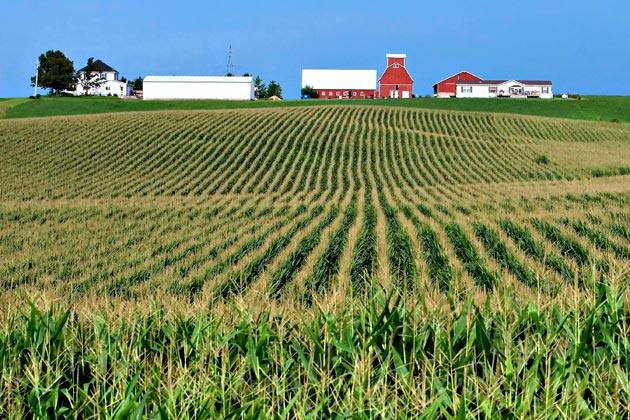Ag barometer remains above levels recorded last year.
July 5, 2017

U.S. agricultural producers indicated their farm operations' financial positions are stronger than at this time in 2016, but expressed concerns that they might not meet their 2017 financial targets, according to a monthly producer survey conducted as part of the Purdue University/CME Group Ag Economy Barometer.
The barometer, which is based on a survey of 400 U.S. agricultural producers, read 131 for the month of June – virtually unchanged from the April and May readings of 130.
"Although the Ag Economy Barometer has not changed appreciably the last couple of months, it's important to note that it remains well above levels recorded prior to November 2016," said Jim Mintert, the barometer's principal investigator and director of Purdue University's Center for Commercial Agriculture.

In June 2017, 13% of survey respondents indicated that their operations were financially better off than a year before - the highest reading since Purdue researchers first started surveying producers in October 2015.
Only 3% of producers expressed that same positive sentiment a year earlier. However, farmers' positive sentiment regarding their operations' financial conditions improved steadily during the last half of 2016, before weakening somewhat this past winter. In the last three months, producers became more optimistic about their farms' financial positions, with 13% of surveyed producers indicating in June that their farms were financially better off than a year earlier.
"Several factors likely contributed to the long-term shift in producers' attitudes about their operations' financial conditions, Mintert said. "Revenues on many farms increased as a result of record - or near record - crop yields in 2016. Also, corn and soybean futures prices strengthened from late summer through early winter while production costs, especially fertilizer, moderated when compared to last year. Farmland rental rates also continue to soften as part of the farm economy's long-term adjustment to tight crop operating margins.”
Mintert said all of this contributed to improved current financial conditions for many farm operations. “Our survey data suggests that for some farm operators, financial conditions have bottomed out."
While the barometer survey indicated the current financial situation for many farm operations had stabilized, 28% of producers said they expect their farms' 2017 financial performance to be worse than they had projected earlier in the year. That concern could be connected to adverse planting and growing conditions in the Eastern Corn Belt this spring, as well as recent declines in corn and soybean prices, Mintert suggested.
The survey also revealed an uptick in producers (52%) expressing concerns that extreme weather events could have widespread adverse impacts on crop yields over the next 12 months.
"Compared to June 2016, producers expressed more concern about the possible impact of extreme weather on crop yields," Mintert said. "One-third of producers in our survey said they had changed their marketing plans in response to weather concerns, up from just 22% in March of this year when we last posed the same question."
More optimism about cattle prices
Since last fall, cattle prices have significantly increased, which the survey showed has resulted in producers being less pessimist about beef cattle prices over the next 12 months. Cattle price expectations were most negative in December 2015, when nearly 45% of respondents said they expected beef cattle prices to be lower 12 months out. Those expectations have changed markedly since then as just 16% of respondents on the June survey expect weaker cattle prices in the year ahead.
Business climate outlook
A theme in the survey from late 2016 and throughout 2017 has been that the business climate for agriculture will improve, according to the investigators.
Previous surveys revealed that producers are more optimistic about the broad U.S. economy than prior to November 2016—40% of producers expect a more favorable regulatory environment in the upcoming five years. Additionally, a majority of survey respondents think efforts to renegotiate the North American Free Trade Agreement (NAFTA) will prove beneficial to U.S. farmers.
In the June survey, producers were asked about their expectations regarding expected changes in taxation to learn whether that is one of the drivers behind their outlook for an improved business climate.
When asked about the taxes affecting agriculture 12 months from now, 18% of producers expect taxes to decline, whereas 30% of respondents actually expect taxes to increase. However, the majority of respondents 52% expect taxes to be about the same as they are today.
One way of summarizing the responses is to say that 70% of producers expect the taxes they face to be about the same or possibly decline in the next 12 months.
When the question was repeated, but over a five-year time horizon instead of 12 months, the share of producers expecting lower taxes remained the same 18%, but producers expecting taxes to be “about the same” fell and those expecting higher taxes increased to 52%.
“Unfortunately, we don’t have a baseline we can use to help evaluate the June survey responses,” the investigators noted. “Having said that, the fact that nearly one-fifth of the survey respondents expect taxes to decline in both the short-run and longer-run suggests that an expectation for a more favorable tax environment is one of the drivers behind the improvement in producer sentiment since last October.”
Overall, U.S. agricultural producers have a more positive outlook for the future and specifically a more noticeable optimism than last fall prior to the November election.
You May Also Like


.png?width=300&auto=webp&quality=80&disable=upscale)
